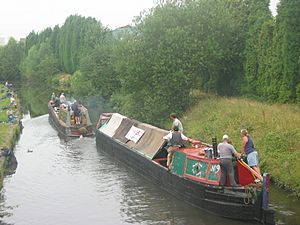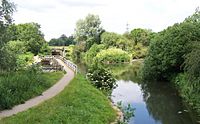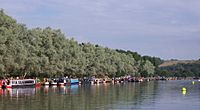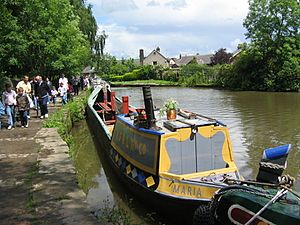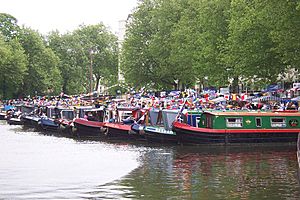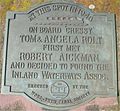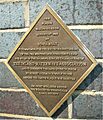Inland Waterways Association facts for kids
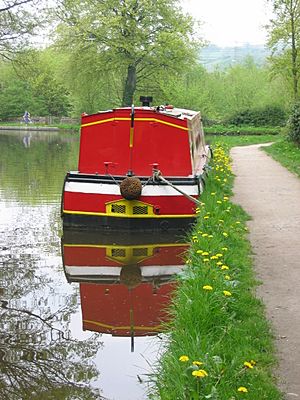
Peak Forest Canal, Whaley Bridge
|
|
| Founded | 1946 |
|---|---|
| Founder |
|
| Registration no. | 212342 |
| Focus | British canals and river navigations. |
|
Area served
|
United Kingdom |
The Inland Waterways Association (IWA) is a special group in the United Kingdom. It is a charity that started in 1946. Its main goal is to protect, use, fix, and improve British canals and river routes.
Some important people who helped start the IWA were L. T. C. Rolt and Robert Aickman.
History of the IWA
How it Started
In 1944, a writer named Tom Rolt published a popular book called Narrow Boat. It was about his journey on canals in 1939. After the book came out, he got a letter from Robert Aickman, who suggested starting a group to help canals.
Tom Rolt liked the idea. So, on August 11, 1945, Tom and Robert, along with their wives, met on Tom's boat, Cressy. They decided to create the Inland Waterways Association. Their first official meeting was on February 15, 1946, in London. Robert Aickman became the chairman, and Tom Rolt was the secretary.
In 1947, the Rolts used their boat Cressy to challenge a railway company. The company had put up a fixed bridge that blocked a canal. After a question was asked in Parliament, the bridge was lifted so Cressy could pass. This showed the IWA's power to make changes!
The IWA also held a successful Inland Waterways Exhibition in London. It was so popular that it traveled to other cities.
Many famous people joined the IWA, like the writer Sir A.P. Herbert and the naturalist Peter Scott.
Saving the Canals
In 1948, the government took control of the canal system. The IWA worked hard to save canals that were falling apart. They even organized a big boat trip in 1948 on northern canals. This trip included what might have been the last journey on the Huddersfield Narrow Canal before it was fixed up in 2001.
The first ever boat rally and festival was held in Market Harborough in August 1950. About 120 boats and 50,000 visitors came! This event helped start the popular boat rallies that the IWA still holds today.
During the 1950s, many canals were not used for business anymore. The IWA kept campaigning to save them. They learned from early attempts and helped form a charity to restore the Warwickshire Avon.
Many local groups also started fighting to save canals like the Oxford Canal and the Kennet and Avon Canal. A group of 30 Members of Parliament (MPs) even became honorary members of the IWA to show their support.
In 1955, a report suggested closing many miles of waterways. The IWA argued that it was cheaper to fix and use canals than to get rid of them. They helped change opinions, and the government decided not to close as many canals.
The fight to save the Kennet and Avon Canal became very important. A group of supporters collected 22,000 signatures for a petition to the Queen! In 1956, a plan to close this canal was stopped.
Canal Restoration Work
In Warwickshire, a lot of hard work went into fixing the Lower Avon River. This project took ten years!
In 1958, a businessman named John Smith suggested that the National Trust could help save the Stratford-upon-Avon Canal. The National Trust agreed to take care of the canal for five years. Another IWA member, David Hutchings, led the restoration work. He finished it on time, even after a very cold winter!
The canal reopened in 1964, just in time for William Shakespeare's 400th birthday celebration in Stratford-upon-Avon. The Queen Mother even took a boat trip to officially reopen the canal! This event was a big success with 200 boats.
This experience led to the creation of the Waterway Recovery Group in 1970. This group is a charity that helps local canal restoration projects. They provide tools, advice, and volunteers. They organize work camps where students and older people can help fix canals. They've worked on many projects, including saving the Peak Forest and Ashton canals.
In 1968, a new law called the Transport Act was passed. It helped canals be used more for fun activities, not just business.
By the 1990s, the Kennet and Avon Canal was fully restored. Also, new lottery money became available from 1994, which helped fund more restoration projects. The IWA's membership grew to about 20,000 people, and their annual boat rallies remained very popular.
How the IWA Works
The IWA is made up of different regions, and each region has several local groups. These regions include East Midlands, London, North West, and others across the UK.
A group of trustees leads the IWA. There are also national committees that focus on different areas, like money, navigation, and restoration. The IWA's Restoration Hub helps and supports projects to fix up waterways.
The current national chairman is Paul Rodgers.
Past Chairmen
- November 2019 to today - Paul Rodgers
- October 2017 to November 2019 - Ivor Caplan
- October 2012 to October 2017 - Les Etheridge
- October 2008 to October 2012 - Clive Henderson
- October 2002 to October 2008 - John Fletcher
- October 1998 to October 2002 - Richard Drake
- October 1994 to October 1998 - Audrey Smith
- October 1989 to October 1994 - David Stevenson
- October 1982 to October 1989 - Ken Goodwin
- October 1972 to October 1982 - John Heap
- April 1972 to October 1982 - Lionel Munk
- August 1970 to April 1972 - John Humphries
- 1958 (Incorporation) to August 1970 - Lionel Munk
Main Activities of the IWA
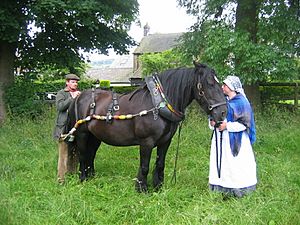
The IWA is a group where members can help make decisions. It has about 16,000 members. Many members own boats (about 60%), but others are interested in fixing canals, walking along waterways, or enjoying wildlife.
Campaigns
The IWA creates plans and runs campaigns to deal with issues that affect the UK's inland waterways. They work to make sure canals and rivers are protected and used well.
Working with Authorities
The IWA works closely with groups that manage waterways, like the Canal & River Trust. They try to have good relationships with these groups to influence decisions and help the waterways.
Restoration
The IWA actively supports fixing up waterways. They offer expert advice and even give money to projects. Their Waterway Recovery Group organizes volunteer holidays to restore waterways across the country. Local groups also do restoration work almost every weekend.
IWA as a Waterway Manager
Since 2005, the IWA has been in charge of managing and maintaining the Chelmer and Blackwater Navigation. This was the first time the IWA took on full responsibility for running a waterway. They formed a special company called Essex Waterways Ltd. to do this.
IWA National Festival
The IWA has organized over 60 National Festivals and Boat Shows. These events are run completely by volunteers. They attract many boats and visitors. For example, the festival at Beale Park in 2006 had 600 boats and 28,000 visitors!
IWA National Campaign Festival
The Campaign Festival is a key part of the IWA's work. By bringing many boats to a specific waterway, it shows how important it is to keep that waterway open. This has helped save many canals from closing.
Past Events
- 2016 - Eldonian Village
- 2014 - Chester
- 2009 - Kiveton Park, Chesterfield Canal
- 2008 - "Monty '08", Theme: Montgomery Canal restoration
- 2006 - Basingstoke Canal
IWA National Trailboat Festival
This festival focuses on smaller boats called trailboats.
Past Events
- 2017 - Ashby Canal
- 2016 - Chesterfield Canal
- 2015 - Lancaster Canal
- 2014 - Grand Western Canal, Devon
- 2013 - River Rother, Bodiam castles, East Sussex
- 2012 - Stroud, Gloucestershire
- 2011 - Neath Canal, South Wales
- 2010 - Monmouthshire Canal, Newport, South Wales
- 2009 - Moira, Ashby Canal, Leicestershire
- 2008 - Grand Western Canal, Devon
- 2007 - Grantham Canal
- 2006 - Lancaster Canal
- 2005 - Chesterfield Canal
- 2002 - Chesterfield Canal
IWA Canalway Cavalcade
This is an annual event held since 1983. It takes place at Little Venice, London, during the early May Bank Holiday weekend. It includes a boat rally, a trade show, and lots of fun activities.
Plaques
There are two plaques at Tardebigge Locks on the Worcester and Birmingham Canal. They remember the 1945 meeting that led to the IWA being founded. In 2015, the IWA also put up a blue plaque at Robert Aickman's old home in London to honor him.
Images for kids


